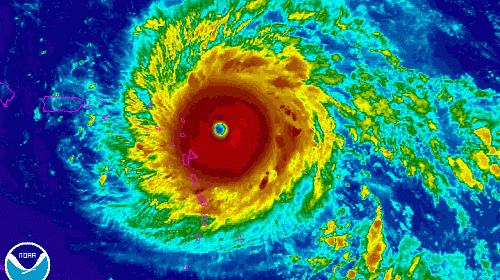PORT AU PRINCE (Sept 5, 2017) — As powerful Hurricane Irma barrels toward Haiti, CARE’s emergency teams on the ground are preparing their response to this potentially devastating storm, readying clean drinking water, food and emergency supplies such as tarps for shelter.
Hurricane Irma, a Category 5 hurricane, is currently in the Atlantic Ocean to the east of the Caribbean Islands. The storm is projected to hit Haiti on Thursday, about a year after the country was devastated by Hurricane Matthew.
“Hurricane Irma could be a monster storm in Haiti, particularly on the heels of Hurricane Matthew’s deadly destruction in the southern part of the country just last October,” warned Karl Paul, CARE Haiti’s country director. “Irma’s biggest threat is flooding and mudslides in addition to damage from the hurricane’s heavy winds and rain. We’re also concerned the anticipated flooding could contaminate the water supply.”
CARE, one of the largest humanitarian organizations in the country, is identifying teams that can be dispatched to any hurricane-ravaged areas. CARE is preparing to respond in at least seven of the 10 departments, or provinces, in Haiti.
CARE teams also have started procuring key emergency supplies such as water purification tablets and tarps that can be used for shelter. CARE also is planning to provide hot meals to people in shelters.
Haiti is still recovering from Hurricane Matthew, which hit the island last year, killing 546 people. Hurricane Irma is unlikely to severely affect those areas affected by Matthew – the forecast shows that Irma’s largest impact will be in the northern regions of the country, not the south which was hard hit by Matthew. Still, there may also be heavy winds and rains in the southern region of the country, including the departments of Grande Anse, the South, and the South-East, compounding Matthew’s previous damage.
Artibonite, West, and Central Plateau departments also are at risk, to a lesser degree. Most vulnerable are Haitians living in poorly-constructed houses in coastal zones, flood-prone zones and mountainous areas. CARE is particularly concerned about people who live in remote areas without access to warning messages.
After Matthew, CARE reached more than 500,000 people with food, clean water, and temporary shelter. “We’re prepared to help again after Irma, but we’re hoping this hurricane spares Haiti,” Paul said.
CARE has been working in Haiti since 1954, following the devastating Hurricane Hazel that killed over 1,000 people. After the deadly 2010 earthquake, CARE reached more than 290,000 people with food, clean water, temporary shelter, and other vital services. Along with responding to emergencies, CARE implements long term development programs such as education, food and livelihoods, and women’s economic empowerment that build the resilience of the most vulnerable families.
About CARE
Founded in 1945, CARE is a leading humanitarian organization fighting global poverty. CARE has more than six decades of experience helping people prepare for disasters, providing lifesaving assistance when a crisis hits, and helping communities recover after the emergency has passed. CARE places special focus on women and children, who are often disproportionately affected by disasters. To learn more visit care.org.
Media Contact
Nicole Harris, nharris@care.org, 404-735-0871.

